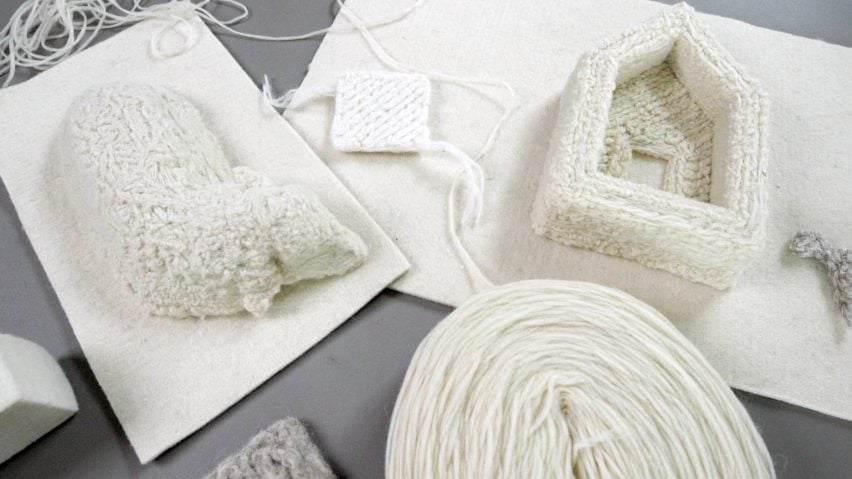Dutch designer Christien Meindertsma has developed a robot that can build three-dimensional volumes out of wool.
Meindertsma's robot, known as the Flocks Wobot, works in a similar way to a 3D printer to build up layers of wool.
Instead of printing out layers of filament, it uses a form of felting to create three-dimensional woven volumes.
"The Wobot is a collaborative robot that makes it possible to build three-dimensional structures with wool industrially for the first time, without adding any material or using water in the felting process," said Meindertsma.
"The three-dimensional wool structures that it creates are strong and soft at the same time."
The project was made possible with the help of robotics company TFT, which worked with Meindertsma to develop a custom robot arm. This attaches to a "cobot", which is a specific type of user-friendly robot.
The attachment works with all different types of wool. However, Meindertsma has found it most effective with coarse wool varieties – like those found on European sheep – as they are more durable.
She believes the technique has many potential applications in design, with examples including furniture, acoustic products and insulation.
"It's a technique you can use with any European wool," the designer told Dezeen.
"The wool doesn't have to be particularly fine and it doesn't even need to be processed, just washed."
The Flocks Wobot was one of two wool research projects that Meindertsma presented at the recent Dutch Design Week, in an exhibition titled The Product Chronicles.
The other was a method for turning wool into soft blocks that can be cut into different shapes, which the designer believes could offer a sustainable alternative to upholstery foam.
She will showcase both techniques in her upcoming solo show, Christien Meindertsma: Re-forming Waste, which opens at the V&A in London on 22 November.
As the third instalment in the V&A's 10-year-long Make Good: Rethinking Material Futures programme, the show will also include Meindertsma's experiments in turning linoleum into a 3D material.
The centrepiece of the exhibition will be a robot-printed sofa, the first large-scale use of this technology.
Meindertsma has worked with different materials across her career, but wool is the one she has become most known for, thanks to projects like One Sheep Sweater and Fibre Market.
Her latest research developed after Rotterdam Circulair – a state-funded programme championing the circular economy – commissioned her to investigate the value of wool on the city's grazing flock.
As with most European sheep, this wool is not fine enough to be used for everyday textiles, so is typically treated as a waste product.
The results of this project were a series of objects that utilised traditional artisan techniques. But Meindertsma felt there was more opportunity to be found in modern manufacturing techniques.
"My conclusion was that traditional techniques still work well, but wool also deserves a modern technique," the designer explained.
It was this that led her to experiment with robotics and 3D printing.
"There were some previous examples of people combining needle felting with 3D printing, but they weren't people with knowledge of wool and how it behaves," she said.
"I realised it shouldn't be exactly like a 3D printer, because 3D-printed filament breaks with certain movements. But with strands of wool, you can do different things."
Meindertsma is also experimenting with different blends of wool, adding in some recycled, dyed yarns as a way of introducing colour.
"My next step is to explore all the possibilities," she concluded.
Christien Meindertsma: Re-forming Waste is on show in the Dr Susan Weber Gallery at the V&A South Kensington in London from 22 November 2023 to 19 October 2024. See Dezeen Events Guide for more design events around the world.

